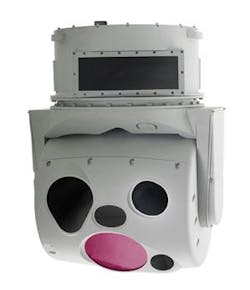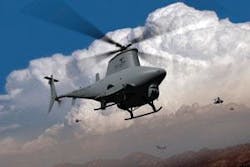Customizing to their needs
Commercial off-the-shelf technologies have streamlined components in defense applications, but some mission-critical situations call for products that must be designed from the ground up to aid warfighters on the battlefield.
By John McHale
More than a dozen years ago when then U.S. Secretary of Defense William Perry issued his famous memo declaring that commercial off-the-shelf (COTS) technology be used whenever possible, the difference between COTS and custom was much more clear than today.
COTS referred to products with part numbers bought off the shelf at commercial prices, whereas custom was designed to military specifications from the ground up with a much higher price tag. The intent of COTS was to eliminate excessive spending that brought about those infamous $600 toilet seats and $400 hammers.
The definitions for COTS and custom electronics respectively and the language describing these terms has branched into other variations of the COTS acronym.
When COTS was first introduced, many companies created marketing synonyms such as MOTS (military off-the-shelf), ROTS (rugged off-the-shelf), and GOTS (government off-the-shelf). This was mostly marketing mumbo jumbo and all the terms were basically COTS. Some new terms include MOTS, now called modified off-the-shelf, NOTS (NATO or niche off-the-shelf), KOTS (kinda off-the-shelf), and the all encompassing other COTS (custom off-the-shelf).
In other words, everyone has a different definition of COTS from the military program manager all the way down to the component vendor. Maybe it is as one defense supplier says, “COTS is whatever my customer says it is.”
Today many COTS vendors say that their customers typically choose a product from a parts list and ask for it to be tweaked for their specific application. This is where the term custom off-the-shelf is coming from. Another way to describe it would be value-added COTS.
Many systems integrators today do not want to spend time programming or ruggedizing boards, so they shift that responsibility onto the suppliers. This is one of the reasons so many hardware companies have a large supply of software engineers-they are writing application code for customers.
Doug Patterson, vice president of sales and marketing at Aitech in Chatsworth, Calif., takes a more black-and-white approach to the custom vs. COTS argument. If a product is not available in the Aitech catalog, “it is not COTS,” he says.
Integrators for the Army’s Future Force Warrior program at the Army Natick Soldier Center Technology Program Office in Natick, Mass., seek out the latest commercial technology and see how it can benefit the systems they are designing for the soldier of the future, whose backpack will consist of an electronic chassis that makes him a node on the battlefield network, says Jean-Louis “Dutch” DeGay, outreach team leader, equipment specialist at the Soldier Center.
“We look for innovative technologies” and get the companies to sign a non-disclosure agreement (NDA) and build a custom version of their product designed to FFW needs, DeGay says. Once the FFW work is done they can offer it as a regular product if they choose.
DeGay’s team evaluates and demonstrates different technologies, and then recommends them to the Program Executive Office (PEO). As such, there is no guarantee that these technologies will make it to the field, but the process creates a qualified military product.
Patterson says this type of situation really only benefits the vendor-providing there is a market for the product they developed under NDA. He cautions, also, that the vendor’s sales may be limited in volume.
An example of an Aitech custom design was the Remote Interface Control Card (RICC) they provided to General Dynamics Land Systems (GDLS) in Sterling Heights, Mich., for the Future Combat Systems (FCS) Manned Ground Vehicle (MGV).
The RICC will be integrated into all the different vehicles that are part of FCS cavalry systems. Each RICC will be installed in one Remote Interface Unit (RIU) enclosure. The RIU enclosure will be developed by GDLS.
While this was a custom design from the ground up, and is only made for one program, Aitech will not offer this as a product on their catalog; it is based on work that company engineers did on other products and systems-some off-the-shelf, some not.
That is one of the reasons “we were able to pull this off quickly, because we were able to build on” previous designs in other systems,” Patterson says.
The system still uses state-of-the-art components, but it was designed specifically for one application, Patterson says. It is not a once-and-done, and has a lifecycle plan that tackles component obsolescence, he explains. “If you have a critical mission in which one vehicle’s RICC units or RIUs go down, you can pull it off a hummer, drop it in, and it works. It performs exactly the same function as the one you just pulled out.”
Mil-spec driven
DRS is typically a “mil-spec house,” says Tim Harrison, vice president, business development at DRS Maritime and Airborne Systems in Cypress, Calif. “If there are COTS elements that fit the environmental profile” and are already qualified, then they will be considered, Harrison says.
When you have a 12-month, no-excuses contract, COTS may sound attractive because of how quickly COTS products can be available but if any of those parts fail there is no time to recover, Harrison says, referring to an airborne sensor payload for the Shadow unmanned aerial vehicle (UAV).
The sense of urgency is greater than ever and the pressure to turn work around more quickly may seem like a good place for COTS. Still, one failure could sink the whole contract, Harrison says. DRS engineers in this case leverage technology they developed for other programs, he adds.
Outside of contract obligations the COTS vendor is not required to support its product indefinitely, and can render products obsolete when it wants, Harrison says. The ultimate burden of support rests with systems integrators, Harrison says.
ASTAMIDS
DRS engineers built the payload for Airborne Surveillance, Target Acquisition and Minefield Detection System (ASTAMIDS) from the ground up with a small portion of COTS at the board level, but otherwise it was custom mil-spec technology, Harrison says.
Minefield detection is not a program that takes a chance with COTS equipment, he adds. The custom approach is crucial especially with thermal control-the need to get the heat out of the ball, Harrison says. This approach typically uses fans or liquid cooling, which must not fail, he adds.
Northrop Grumman’s ASTAMIDS detects and locates minefields and obstacles to enable maneuver commanders to decide whether to clear or avoid them, Army officials say.
“Our baseline countermine design included some inherent RSTA [reconnaissance, surveillance, and target acquisition] and target designation applications capability in the original proposal,” says Dave Gilbert, the ASTAMIDS program manager for Northrop Grumman Integrated Systems-the prime contractor for ASTAMIDS. “This program expansion leverages those inherent capabilities with a tracking and designation capability to fulfill counter-mine and RSTA missions for the U.S. Army.”
The Airborne Payload (AP) provided by DRS Technologies consists of multi-spectral electro-optical sensors covering the visible and near-infrared (VNIR) and midwave infrared (MWIR) portions of the spectrum. The AP contains mission-specific hardware, software, and firmware components installed in the Future Combat Systems UAV. It collects and analyzes imagery and data and transmits the products via the Network Data Link to the FCS Ground Control Station.
The ASTAMIDS program will operate on the Army Future Combat System RQ-8B Fire Scout Class IV unmanned helicopter that Northrop Grumman is developing with day or night capability. ASTAMIDS carries an integrated, multi-sensor, electro-optical infrared/multi-spectral imaging payload to detect patterned surface-placed mines, patterned recently buried mines, and randomly scattered mines. The payload can detect obstacles, combat vehicles, and other targets, including those under camouflage.
ASTAMIDS uses quad-prism aperture-splitting technology with the aid of an integrated illuminator and target laser rangefinder and designator. The Army is developing change-detection algorithms to insert into the FCS program, to address improvised explosive devices and single on-route mines by processing ASTAMIDS imagery.
ASTAMIDS consists of two subsystems: the Airborne Payload and the Tactical Ground Segment (TGS). DRS is delivering the first ASTAMIDS payload to Northrop Grumman in Melbourne, Fla., later this year, Harrison says. DRS is also delivering an airborne sensor payload for the Army OH-58D Kiowa helicopters that includes mast-mounted sites and other forward-looking infrared receivers.
Custom software
Typically software for military applications is a not a stand-alone off-the-shelf-product, says Gary Cato, director of strategic alliances at Aonix in San Diego. Off-the-shelf products can handle general-purpose tasks but customers usually need software that is optimized for specific applications, he continues.
While this is not custom, it is not exactly COTS either, Cato says, because it is tailored to a specific customer’s needs. Also when a software tool is developed for specific processors, it will take a couple years until all the nuances of multicore processors are understood, so the code will continually evolve based on this process, he explains.
Vendors such as Aonix typically cannot develop safety-critical applications on speculation because software will only be certified when the customer pays for it, Cato continues. For Aonix a custom development would be “when a customer comes to us with specific needs” and specifies that the product will not be used anywhere else, he says.
Officials at FLIR Systems in Portland, Ore., also pursue a philosophy that falls between COTS and custom. Their method is called “commercially developed, military qualified (CDMQ),” which accesses FLIR’s open production lines of cross-platform sensor systems, says David Strong, vice president of marketing for FLIR Government Systems. FLIR’s CDMQ combines mil-spec equipment with commercial business practices, he adds.
The main benefit to customers is the lack of a requirement to foot the NRE bills, Strong says. That burden is placed on the vendor instead of the government customer. FLIR also makes most of its own components in house, providing vertical integration, Strong says.
BAE systems officials are taking a similar approach to FLIR but on a much larger scale in several platforms and areas of their business. The company unveiled its Q-Sight family of helmet displays and tracking products last month at the Association of the U.S. Army’s Annual Symposium and Exhibition in Washington. The Q-Sight was developed from the ground up with custom optics without an existing contract.
Driving specifications internally without pursuing the specific needs of just one customer enables a design for an entire market, says George Lim, business development director of helmets at BAE Systems Platform Solutions in Johnson City, N.Y. It also gives the technology more time to mature.
The helmet system features a lightweight, ergonomic design and increased visibility, flexibility, and reliability. Weighing less than 4 ounces, the miniature display clips to any helmet, giving the pilot “plug-and-play” ease of use.
For the last couple years BAE Systems engineers pursued this product development approach to designing whole autonomous vehicles with their own money. BAE developed the Talisman unmanned underwater vehicle (UUV) and the Talisman M Configuration for mine countermeasures through company private venture funding, not via a military contract with any government, company officials say.
The Talisman UUV is capable of a wide range of maritime littoral operations. “Talisman M can perform the type of dangerous roles currently performed by service men and women throughout the world-locate, identify, and neutralize mines in one single mission without the need for human intervention,” says Andy Tonge, Talisman project manager at BAE Systems Underwater Systems. “Using technology from the non-defense industry has enabled us to develop this UUV more swiftly and cost effectively and to introduce innovative solutions. This is part of an overall strategy across BAE Systems to build up an integrated approach to unmanned vehicles and autonomous systems, leading to the development of Intelligent Autonomy, which can be applied across land, sea, and air,” Tonge continues.
Earlier this year, Adam Ingram, United Kingdom minister of state for the country’s armed forces, said “the primary requirement that the Royal Navy currently has for UUVs is for mine countermeasures. The Navy’s future mine countermeasures strategy sets out our aspiration for a range of fully autonomous UUVs, capable of conducting mine detection, classification, and neutralization while the parent platform remains at a safe distance.”
The UUV program was developed and managed by BAE Systems at its Underwater Systems business in Waterlooville, England.
BAE Systems selects Advanced Knowledge Associates system-on-module technology for Bradley fighting vehicles
Officials at Advanced Knowledge Associates (AKA), in Santa Clara, Calif., are providing miniaturized, reconfigurable, self-contained system-on-module (SOM) technology to BAE Systems.
AKA will deliver circuit card assemblies and modules for remanufactured Bradley fighting vehicles. The company’s SOM devices are off-the-shelf, but customized for specific customer applications, says Guy Marom, AKA president.
The 2-by-2-inch rugged and compact models can replace boards and daughter card assemblies, and are equipped to deal with shock, vibration, and temperature extremes. The modules are not subject to obsolescence issues to the same degree as individual components, company officials say. AKA modules incorporate approximately 300 components, yet are simple to replace, reuse, and upgrade.
The A3 Bradley is one of the most advanced, digitized combat systems at the forefront of U.S. Army operations around the world. It provides survivability, mobility, and lethality to U.S. soldiers in all types of close-combat urban environments and open terrain scenarios.
For more information, visit www.advancedknowledgeassociates.com.
Vicor offers suite of design tools for custom power systems
Vicor Corp. in Andover, Mass., is announcing PowerBench, an online suite of power design tools that enable power designers to specify and verify the performance and attributes of custom power design solutions in real time.
The tools enable design engineers to focus on their ideas rather than the constraints dictated by power supply availability, Vicor officials say.
PowerBench encompasses the design of DC-DC converters, AC-DC and DC-DC partitioned power architecture (VIPAC and VIPAC Arrays), and power-factor corrected AC-DC power supplies.
PowerBench has three major elements. The first, CMDS (Custom Module Design System), supports Vicor’s FasTrak Maxi, Mini, and Micro DC-DC converters with any output voltage between 2 and 48 volts DC and with any input voltage from 18 volts DC minimum to 425 volts DC maximum with input voltage ranges up to 2.1 to 1. Output power is selectable over a continuous range of 20 to 500 watts per module and modules can be configured in fault-tolerant arrays capable of delivering several kilowatts.
Next is VCAD (Vicor Configurable Automated Design), which is the heart of Vicor’s VIPAC, a type of power system that leverages advances in DC-DC converters and modular front-ends and incorporates a new partitioned power architecture.
Last is VSPOC (Vicor Systems Product Online Configurator), which is a proprietary online system that enables a registered user to specify and verify complete power solutions in real time.
For more information, contact Vicor online at www.vicorpower.com.
DRS Technologies to produce Phalanx Thermal Imagers for U.S. Navy weapon systems
DRS Sensors & Targeting Systems in Cypress, Calif., will produce thermal imagers for the MK 15 Phalanx Close-In Weapon System (CIWS). Raytheon Missile Systems in Louisville, Ky., awarded the contract.
The imagers were developed by the company’s DRS-produced work for this contract will be accomplished by the unit’s Optronics Division in Palm Bay, Fla. DRS will start delivering the imagers immediately with completion expected by July 2008.
The Phalanx CIWS is a shipboard defense weapon system currently deployed on every class of U.S. Navy combat ship, as well as on various international vessels. It is a fast-reaction, rapid-fire, 20-millimeter gun system that automatically detects, tracks, and engages incoming anti-ship missiles, aircraft and littoral warfare threats and is designed to be used at short ranges. It provides ships with a “last-chance” self-defense capability against these threats that have penetrated other fleet defense systems.
“Using the DRS-produced Phalanx Thermal Imager is a significant upgrade to the existing, first-generation Forward Looking Infrared (FLIR) system currently incorporated into the Phalanx weapon system,” says James M. Baird, president of DRS’s Reconnaissance, Surveillance & Target Acquisition (RSTA) segment.
The DRS’s Phalanx CIWS contains fully integrated radar and infrared surveillance capabilities for the automatic or manual acquisition and tracking of enemy threats. DRS’s Phalanx Thermal Imagers incorporate the second-generation FLIR technology similar to that used by the company in the Horizontal Technology Integration series of sighting system products, currently being produced and delivered to the U.S. Army and U.S. Marine Corps for ground combat systems.
The RSTA Segment develops, manufactures, and supports electro-optical technologies, including advanced cooled and uncooled thermal imaging solutions for soldier systems, ground vehicle, airborne and maritime, as well as for industrial, security, public safety, and firefighting applications.




